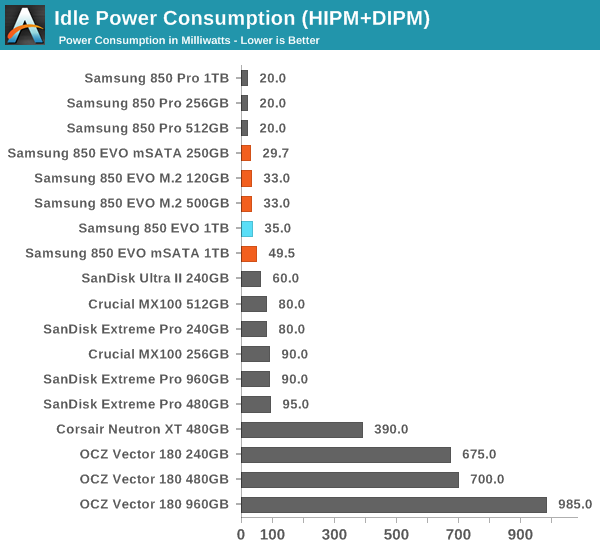The Samsung SSD 850 EVO mSATA/M.2 Review
by Kristian Vättö on March 31, 2015 10:00 AM ESTIdle Power Consumption
Since we truncuate idle times to 25µs in our Storage Bench traces, they don't give a fully accurate picture of real world power consumption as idle power consumption is not taken properly into account. Hence I'm still reporting idle power consumption as a separate benchmark because it's one of the most critical metrics when it comes evaluating an SSD for mobile use.
Unfortunately I still don't have a way to test DevSleep power consumption due to lack of platform support, but my testbed supports HIPM+DIPM power commands (also referred to as Slumber power), so the results give a rather accurate picture of real-world idle power consumption.

All Samsung's recent SSDs have had excellent idle power consumption and the 850 EVO mSATA/M.2 is no exception.
TRIM Validation
The move from Windows 7 to 8.1 introduced some problems with the methodology we have previously used to test TRIM functionality, so I had to come up with a new way to test. I tested a couple of different methods, but ultimately I decided to go with the easiest one that can actually be used by anyone. The software is simply called trimcheck and it was made by a developer that goes by the name CyberShadow in GitHub.
Trimcheck tests TRIM by creating a small, unique file and then deleting it. Next the program will check whether the data is still accessible by reading the raw LBA locations. If the data that is returned by the drive is all zeros, it has received the TRIM command and TRIM is functional.
And TRIM appears to be working fine.











58 Comments
View All Comments
Peichen - Tuesday, March 31, 2015 - link
Shouldn't mSATA/M.2 intereface drives be a lot faster than SATAIII drives due to the much faster interface? I was kinda expecting 1GB/sec. speed consider there are already drive tested at 1.4 and 2.7GB/sec.MrCommunistGen - Tuesday, March 31, 2015 - link
mSATA is SATA in a different formfactor. M.2 can be either SATA or PCI-E. As stated in the article, this drive comes (only) in the SATA form.foxtrot1_1 - Tuesday, March 31, 2015 - link
The interface is still SATA, even if the connector is M.2. I assume PCIe M.2 drives will be coming later.Murloc - Tuesday, March 31, 2015 - link
in a very short time they introduced a bunch of connectors and interfaces and it's all gotten quite confusing.foxtrot1_1 - Tuesday, March 31, 2015 - link
Don't worry, it's not like there's also three different mainstream USB standards with two different plugs. Oh wait.Well, at least we have one agreed-upon display connection, that makes shopping for monitors and graphics cards easier. Oh wait.
lazarpandar - Tuesday, March 31, 2015 - link
That's the great thing about standards, you've got so many to choose from!yslee - Tuesday, March 31, 2015 - link
xkcd #927 puts it very nicely. :PArtuk - Wednesday, April 1, 2015 - link
Niceblanarahul - Tuesday, March 31, 2015 - link
You need yo put /sarcasm tag so people don't get confused.Callitrax - Tuesday, March 31, 2015 - link
One thing you should probably do in M.2 SSD reviews is include how the drives are keyed, preferably in one of the tables. This is important since the M.2 interface is actually 4 semi compatible "standards" (see http://arstechnica.com/gadgets/2015/02/understandi... As a result not all M.2 SSDs will fit in all M.2 slots. This one appears to be both B and M keyed so I think it should be pretty universal, but as an example the Samsung XP941 is only M keyed and thus will not work in the HP Stream Mini's B keyed SSD slot. (Did whoever came up with M.2 make a crappy standard that will cause lots of customer support calls and RMA's when consumers M.2 drives don't work with their M.2 equipped computers? Yes they did.)